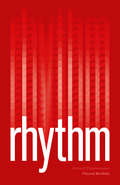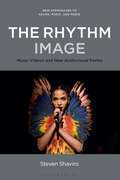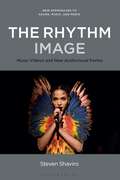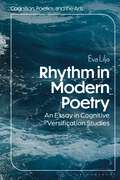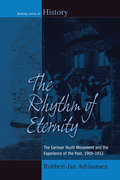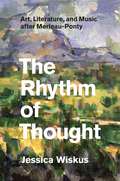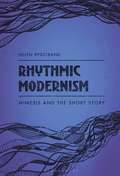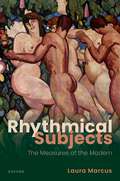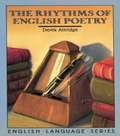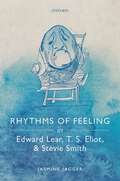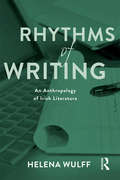- Table View
- List View
Rhythm: Form and Dispossession
by Vincent BarlettaMore than the persistent beat of a song or the structural frame of poetry, rhythm is a deeply imbedded force that drives our world and is also a central component of the condition of human existence. It’s the pulse of the body, a power that orders matter, a strange and natural force that flows through us. Virginia Woolf describes it as a “wave in the mind” that carries us, something we can no more escape than we could stop our hearts from beating. Vincent Barletta explores rhythm through three historical moments, each addressing it as a phenomenon that transcends poetry, aesthetics, and even temporality. He reveals rhythm to be a power that holds us in place, dispossesses us, and shapes the foundations of our world. In these moments, Barletta encounters rhythm as a primordial and physical binding force that establishes order and form in the ancient world, as the anatomy of lived experience in early modern Europe, and as a subject of aesthetic and ethical questioning in the twentieth century. A wide-ranging book covering a period spanning two millennia and texts from over ten languages, Rhythm will expand the conversation around this complex and powerful phenomenon.
Rhythm: Form and Dispossession
by Vincent BarlettaMore than the persistent beat of a song or the structural frame of poetry, rhythm is a deeply imbedded force that drives our world and is also a central component of the condition of human existence. It’s the pulse of the body, a power that orders matter, a strange and natural force that flows through us. Virginia Woolf describes it as a “wave in the mind” that carries us, something we can no more escape than we could stop our hearts from beating. Vincent Barletta explores rhythm through three historical moments, each addressing it as a phenomenon that transcends poetry, aesthetics, and even temporality. He reveals rhythm to be a power that holds us in place, dispossesses us, and shapes the foundations of our world. In these moments, Barletta encounters rhythm as a primordial and physical binding force that establishes order and form in the ancient world, as the anatomy of lived experience in early modern Europe, and as a subject of aesthetic and ethical questioning in the twentieth century. A wide-ranging book covering a period spanning two millennia and texts from over ten languages, Rhythm will expand the conversation around this complex and powerful phenomenon.
Rhythm: Form and Dispossession
by Vincent BarlettaMore than the persistent beat of a song or the structural frame of poetry, rhythm is a deeply imbedded force that drives our world and is also a central component of the condition of human existence. It’s the pulse of the body, a power that orders matter, a strange and natural force that flows through us. Virginia Woolf describes it as a “wave in the mind” that carries us, something we can no more escape than we could stop our hearts from beating. Vincent Barletta explores rhythm through three historical moments, each addressing it as a phenomenon that transcends poetry, aesthetics, and even temporality. He reveals rhythm to be a power that holds us in place, dispossesses us, and shapes the foundations of our world. In these moments, Barletta encounters rhythm as a primordial and physical binding force that establishes order and form in the ancient world, as the anatomy of lived experience in early modern Europe, and as a subject of aesthetic and ethical questioning in the twentieth century. A wide-ranging book covering a period spanning two millennia and texts from over ten languages, Rhythm will expand the conversation around this complex and powerful phenomenon.
Rhythm: Form and Dispossession
by Vincent BarlettaMore than the persistent beat of a song or the structural frame of poetry, rhythm is a deeply imbedded force that drives our world and is also a central component of the condition of human existence. It’s the pulse of the body, a power that orders matter, a strange and natural force that flows through us. Virginia Woolf describes it as a “wave in the mind” that carries us, something we can no more escape than we could stop our hearts from beating. Vincent Barletta explores rhythm through three historical moments, each addressing it as a phenomenon that transcends poetry, aesthetics, and even temporality. He reveals rhythm to be a power that holds us in place, dispossesses us, and shapes the foundations of our world. In these moments, Barletta encounters rhythm as a primordial and physical binding force that establishes order and form in the ancient world, as the anatomy of lived experience in early modern Europe, and as a subject of aesthetic and ethical questioning in the twentieth century. A wide-ranging book covering a period spanning two millennia and texts from over ten languages, Rhythm will expand the conversation around this complex and powerful phenomenon.
Rhythm: Form and Dispossession
by Vincent BarlettaMore than the persistent beat of a song or the structural frame of poetry, rhythm is a deeply imbedded force that drives our world and is also a central component of the condition of human existence. It’s the pulse of the body, a power that orders matter, a strange and natural force that flows through us. Virginia Woolf describes it as a “wave in the mind” that carries us, something we can no more escape than we could stop our hearts from beating. Vincent Barletta explores rhythm through three historical moments, each addressing it as a phenomenon that transcends poetry, aesthetics, and even temporality. He reveals rhythm to be a power that holds us in place, dispossesses us, and shapes the foundations of our world. In these moments, Barletta encounters rhythm as a primordial and physical binding force that establishes order and form in the ancient world, as the anatomy of lived experience in early modern Europe, and as a subject of aesthetic and ethical questioning in the twentieth century. A wide-ranging book covering a period spanning two millennia and texts from over ten languages, Rhythm will expand the conversation around this complex and powerful phenomenon.
Rhythm and Meter: Phonetics and Phonology, Vol. 1
by Paul Kiparsky Gilbert YoumansPhonetics and Phonology: Volume 1, Rhythm and Meter compiles original articles by 12 linguists and literary critics who have made important contributions to current theories of phonology, verse meter, and music. This book mainly focuses on English poetry—on the meters of Shakespeare, Milton, Blake, Longfellow, Hopkins, Auden, and other Renaissance dramatists. Poetry in other languages that include Greek, Arabic, Hebrew, Russian, and German are also examined. This publication emphasizes metrical theory, formulating and illustrating metrical principles within the tradition of generative metrics and competing traditions. The relationships between rhythm in language and music are likewise analyzed. This volume is useful to linguists, literary critics, and specialists conducting work on rhythm and meter.
The Rhythm Image: Music Videos and New Audiovisual Forms (New Approaches to Sound, Music, and Media)
by Steven ShaviroMusic videos play a critical role in our age of ubiquitous streaming digital media. They project the personas and visions of musical artists; they stand at the cutting edge of developments in popular culture; and they fuse and revise multiple frames of reference, from dance to high fashion to cult movies and television shows to Internet memes. Above all, music videos are laboratories for experimenting with new forms of audiovisual expression. The Rhythm Image explores all these dimensions. The book analyzes, in depth, recent music videos for artists ranging from pop superstar The Weeknd to independent women artists like FKA twigs and Dawn Richard. The music videos discussed in this book all treat the traditional themes of popular music: sex and romance, money and fame, and the lived experiences of race and gender. But they twist these themes in strange and unexpected ways, in order to reflect our entanglement with a digital world of social media, data gathering, and 24/7 demands upon our attention.
The Rhythm Image: Music Videos and New Audiovisual Forms (New Approaches to Sound, Music, and Media)
by Steven ShaviroMusic videos play a critical role in our age of ubiquitous streaming digital media. They project the personas and visions of musical artists; they stand at the cutting edge of developments in popular culture; and they fuse and revise multiple frames of reference, from dance to high fashion to cult movies and television shows to Internet memes. Above all, music videos are laboratories for experimenting with new forms of audiovisual expression. The Rhythm Image explores all these dimensions. The book analyzes, in depth, recent music videos for artists ranging from pop superstar The Weeknd to independent women artists like FKA twigs and Dawn Richard. The music videos discussed in this book all treat the traditional themes of popular music: sex and romance, money and fame, and the lived experiences of race and gender. But they twist these themes in strange and unexpected ways, in order to reflect our entanglement with a digital world of social media, data gathering, and 24/7 demands upon our attention.
Rhythm in Modern Poetry: An Essay in Cognitive Versification Studies (Cognition, Poetics, and the Arts)
by Professor Emerit Eva LiljaA pioneering work in cognitive versification studies, scrutinizing the rhythmical means of free verse.Investigating a previously neglected area of study, Rhythm in Modern Poetry establishes a foundation for cognitive versification studies with a focus on the modernist free verse. Following in the tradition of cognitive poetics by Reuven Tsur, Richard Cureton and Derek Attridge, every chapter investigates the rhythms of one modern poem, by Lawrence Ferlinghetti, Sylvia Plath and others, and engages each element in the broader interpretation of the poem in question. In her examination of modernist poetry in English and other Germanic languages, Eva Lilja expands her analysis to discuss both the Ancient Greek and Norse origins of rhythm in free verse and the intermedia intersection, comparing poetic rhythm with rhythm in pictures, sculptures and dance. Rhythm in Modern Poetry thus expands the field of cognitive versification studies while also engaging readers writ large interested in how rhythm works in the aesthetic field.
The Rhythm of Eternity: The German Youth Movement and the Experience of the Past, 1900-1933 (Making Sense of History #22)
by Robbert-Jan AdriaansenThe Weimar era in Germany is often characterized as a time of significant change. Such periods of rupture transform the way people envision the past, present, and future. This book traces the conceptions of time and history in the Germany of the early 20th century. By focusing on both the discourse and practices of the youth movement, the author shows how it reinterpreted and revived the past to overthrow the premises of modern historical thought. In so doing, this book provides insight into the social implications of the ideological de-historicization of the past.
The Rhythm of Thought: Art, Literature, and Music after Merleau-Ponty
by Jessica WiskusBetween present and past, visible and invisible, and sensation and idea, there is resonance—so philosopher Maurice Merleau-Ponty argued and so Jessica Wiskus explores in The Rhythm of Thought. Holding the poetry of Stéphane Mallarmé, the paintings of Paul Cézanne, the prose of Marcel Proust, and the music of Claude Debussy under Merleau-Ponty’s phenomenological light, she offers innovative interpretations of some of these artists’ masterworks, in turn articulating a new perspective on Merleau-Ponty’s philosophy. More than merely recovering Merleau-Ponty’s thought, Wiskus thinks according to it. First examining these artists in relation to noncoincidence—as silence in poetry, depth in painting, memory in literature, and rhythm in music—she moves through an array of their artworks toward some of Merleau-Ponty’s most exciting themes: our bodily relationship to the world and the dynamic process of expression. She closes with an examination of synesthesia as an intertwining of internal and external realms and a call, finally, for philosophical inquiry as a mode of artistic expression. Structured like a piece of music itself, The Rhythm of Thought offers new contexts in which to approach art, philosophy, and the resonance between them.
The Rhythm of Thought: Art, Literature, and Music after Merleau-Ponty
by Jessica WiskusBetween present and past, visible and invisible, and sensation and idea, there is resonance—so philosopher Maurice Merleau-Ponty argued and so Jessica Wiskus explores in The Rhythm of Thought. Holding the poetry of Stéphane Mallarmé, the paintings of Paul Cézanne, the prose of Marcel Proust, and the music of Claude Debussy under Merleau-Ponty’s phenomenological light, she offers innovative interpretations of some of these artists’ masterworks, in turn articulating a new perspective on Merleau-Ponty’s philosophy. More than merely recovering Merleau-Ponty’s thought, Wiskus thinks according to it. First examining these artists in relation to noncoincidence—as silence in poetry, depth in painting, memory in literature, and rhythm in music—she moves through an array of their artworks toward some of Merleau-Ponty’s most exciting themes: our bodily relationship to the world and the dynamic process of expression. She closes with an examination of synesthesia as an intertwining of internal and external realms and a call, finally, for philosophical inquiry as a mode of artistic expression. Structured like a piece of music itself, The Rhythm of Thought offers new contexts in which to approach art, philosophy, and the resonance between them.
The Rhythm of Thought: Art, Literature, and Music after Merleau-Ponty
by Jessica WiskusBetween present and past, visible and invisible, and sensation and idea, there is resonance—so philosopher Maurice Merleau-Ponty argued and so Jessica Wiskus explores in The Rhythm of Thought. Holding the poetry of Stéphane Mallarmé, the paintings of Paul Cézanne, the prose of Marcel Proust, and the music of Claude Debussy under Merleau-Ponty’s phenomenological light, she offers innovative interpretations of some of these artists’ masterworks, in turn articulating a new perspective on Merleau-Ponty’s philosophy. More than merely recovering Merleau-Ponty’s thought, Wiskus thinks according to it. First examining these artists in relation to noncoincidence—as silence in poetry, depth in painting, memory in literature, and rhythm in music—she moves through an array of their artworks toward some of Merleau-Ponty’s most exciting themes: our bodily relationship to the world and the dynamic process of expression. She closes with an examination of synesthesia as an intertwining of internal and external realms and a call, finally, for philosophical inquiry as a mode of artistic expression. Structured like a piece of music itself, The Rhythm of Thought offers new contexts in which to approach art, philosophy, and the resonance between them.
The Rhythm of Thought: Art, Literature, and Music after Merleau-Ponty
by Jessica WiskusBetween present and past, visible and invisible, and sensation and idea, there is resonance—so philosopher Maurice Merleau-Ponty argued and so Jessica Wiskus explores in The Rhythm of Thought. Holding the poetry of Stéphane Mallarmé, the paintings of Paul Cézanne, the prose of Marcel Proust, and the music of Claude Debussy under Merleau-Ponty’s phenomenological light, she offers innovative interpretations of some of these artists’ masterworks, in turn articulating a new perspective on Merleau-Ponty’s philosophy. More than merely recovering Merleau-Ponty’s thought, Wiskus thinks according to it. First examining these artists in relation to noncoincidence—as silence in poetry, depth in painting, memory in literature, and rhythm in music—she moves through an array of their artworks toward some of Merleau-Ponty’s most exciting themes: our bodily relationship to the world and the dynamic process of expression. She closes with an examination of synesthesia as an intertwining of internal and external realms and a call, finally, for philosophical inquiry as a mode of artistic expression. Structured like a piece of music itself, The Rhythm of Thought offers new contexts in which to approach art, philosophy, and the resonance between them.
The Rhythm of Thought: Art, Literature, and Music after Merleau-Ponty
by Jessica WiskusBetween present and past, visible and invisible, and sensation and idea, there is resonance—so philosopher Maurice Merleau-Ponty argued and so Jessica Wiskus explores in The Rhythm of Thought. Holding the poetry of Stéphane Mallarmé, the paintings of Paul Cézanne, the prose of Marcel Proust, and the music of Claude Debussy under Merleau-Ponty’s phenomenological light, she offers innovative interpretations of some of these artists’ masterworks, in turn articulating a new perspective on Merleau-Ponty’s philosophy. More than merely recovering Merleau-Ponty’s thought, Wiskus thinks according to it. First examining these artists in relation to noncoincidence—as silence in poetry, depth in painting, memory in literature, and rhythm in music—she moves through an array of their artworks toward some of Merleau-Ponty’s most exciting themes: our bodily relationship to the world and the dynamic process of expression. She closes with an examination of synesthesia as an intertwining of internal and external realms and a call, finally, for philosophical inquiry as a mode of artistic expression. Structured like a piece of music itself, The Rhythm of Thought offers new contexts in which to approach art, philosophy, and the resonance between them.
The Rhythm of Thought: Art, Literature, and Music after Merleau-Ponty
by Jessica WiskusBetween present and past, visible and invisible, and sensation and idea, there is resonance—so philosopher Maurice Merleau-Ponty argued and so Jessica Wiskus explores in The Rhythm of Thought. Holding the poetry of Stéphane Mallarmé, the paintings of Paul Cézanne, the prose of Marcel Proust, and the music of Claude Debussy under Merleau-Ponty’s phenomenological light, she offers innovative interpretations of some of these artists’ masterworks, in turn articulating a new perspective on Merleau-Ponty’s philosophy. More than merely recovering Merleau-Ponty’s thought, Wiskus thinks according to it. First examining these artists in relation to noncoincidence—as silence in poetry, depth in painting, memory in literature, and rhythm in music—she moves through an array of their artworks toward some of Merleau-Ponty’s most exciting themes: our bodily relationship to the world and the dynamic process of expression. She closes with an examination of synesthesia as an intertwining of internal and external realms and a call, finally, for philosophical inquiry as a mode of artistic expression. Structured like a piece of music itself, The Rhythm of Thought offers new contexts in which to approach art, philosophy, and the resonance between them.
Rhythmic Modernism: Mimesis and the Short Story
by Helen RydstrandContrary to the common view that cultural modernism is a broadly anti-mimetic movement, one which turned away from traditional artistic goals of representing the world, Rhythmic Modernism argues that rhythm and mimesis are central to modernist aesthetics. Through detailed close readings of non-fiction and short stories, Helen Rydstrand shows that textual rhythms comprised the substance of modernist mimesis. Rhythmic Modernism demonstrates how many modernist writers, such as D. H. Lawrence, Katherine Mansfield and Virginia Woolf, were profoundly invested in mimicking a substratum of existence that was conceived as rhythmic, each displaying a fascination with rhythm, both as a formal device and as a vital, protean concept that helped to make sense of the complex modern world.
Rhythmic Modernism: Mimesis and the Short Story
by Helen RydstrandContrary to the common view that cultural modernism is a broadly anti-mimetic movement, one which turned away from traditional artistic goals of representing the world, Rhythmic Modernism argues that rhythm and mimesis are central to modernist aesthetics. Through detailed close readings of non-fiction and short stories, Helen Rydstrand shows that textual rhythms comprised the substance of modernist mimesis. Rhythmic Modernism demonstrates how many modernist writers, such as D. H. Lawrence, Katherine Mansfield and Virginia Woolf, were profoundly invested in mimicking a substratum of existence that was conceived as rhythmic, each displaying a fascination with rhythm, both as a formal device and as a vital, protean concept that helped to make sense of the complex modern world.
Rhythmical Subjects: The Measures of the Modern
by Laura MarcusTracing a developing fascination with rhythm's significance, its patterns, and its measures, across philosophy, psychology, science, and the whole range of arts, Rhythmical Subjects shows how and why attention to rhythm came to serve as connective tissue between fields of inquiry at a time when modern disciplines were still in the process of formation or consolidation. The concentration on 'rhythm' and its cognates largely arose, Laura Marcus demonstrates, from the desire to reclaim or retain human and natural measures in the face of the coming of the machine and the speed of technological innovation. Rhythmical Subjects uncovers the disparate routes by which rhythm acquired its newfound ability to link ancient and modern forms of intellectual inquiry, and to fathom and re-invigorate temporal articulations of modern subjective life. Among the numerous intellectual and artistic developments set in a new light by this brilliantly wide-ranging book are: the long line of philosophical and theoretical writing on rhythm, from Nietzsche to Bergson and their twentieth-century interlocutors; psychological explorations of rhythm as the fundamental law of life, from Herbert Spencer and Ralph Waldo Emerson to Elsie Fogarty; more experimental engagements with psychology's rhythms, from Wilhelm Wundt, Théodule Ribot, and Karl Groos to the aesthetic writings of Vernon Lee; the history of prosody; pioneering applications of rhythm studies to social and sexual reform, by Havelock Ellis, Marie Stopes, D. H. Lawrence, and Mary Austin (among others); Lebensreform movements and the contribution of Rudolf Steiner and Emile Jaques-Dalcroze; and numerous endeavours in artistic and critical innovation, from the small modernist magazines of Bloomsbury and Paris to art salons and dance studios across Britain, Continental Europe, and America.
Rhythmical Subjects: The Measures of the Modern
by Laura MarcusTracing a developing fascination with rhythm's significance, its patterns, and its measures, across philosophy, psychology, science, and the whole range of arts, Rhythmical Subjects shows how and why attention to rhythm came to serve as connective tissue between fields of inquiry at a time when modern disciplines were still in the process of formation or consolidation. The concentration on 'rhythm' and its cognates largely arose, Laura Marcus demonstrates, from the desire to reclaim or retain human and natural measures in the face of the coming of the machine and the speed of technological innovation. Rhythmical Subjects uncovers the disparate routes by which rhythm acquired its newfound ability to link ancient and modern forms of intellectual inquiry, and to fathom and re-invigorate temporal articulations of modern subjective life. Among the numerous intellectual and artistic developments set in a new light by this brilliantly wide-ranging book are: the long line of philosophical and theoretical writing on rhythm, from Nietzsche to Bergson and their twentieth-century interlocutors; psychological explorations of rhythm as the fundamental law of life, from Herbert Spencer and Ralph Waldo Emerson to Elsie Fogarty; more experimental engagements with psychology's rhythms, from Wilhelm Wundt, Théodule Ribot, and Karl Groos to the aesthetic writings of Vernon Lee; the history of prosody; pioneering applications of rhythm studies to social and sexual reform, by Havelock Ellis, Marie Stopes, D. H. Lawrence, and Mary Austin (among others); Lebensreform movements and the contribution of Rudolf Steiner and Emile Jaques-Dalcroze; and numerous endeavours in artistic and critical innovation, from the small modernist magazines of Bloomsbury and Paris to art salons and dance studios across Britain, Continental Europe, and America.
The Rhythms of English Poetry
by Derek AttridgeExamines the way in which poetry in English makes use of rhythm. The author argues that there are three major influences which determine the verse-forms used in any language: the natural rhythm of the spoken language itself; the properties of rhythmic form; and the metrical conventions which have grown up within the literary tradition. He investigates these in order to explain the forms of English verse, and to show how rhythm and metre work as an essential part of the reader's experience of poetry.
The Rhythms of English Poetry
by Derek AttridgeExamines the way in which poetry in English makes use of rhythm. The author argues that there are three major influences which determine the verse-forms used in any language: the natural rhythm of the spoken language itself; the properties of rhythmic form; and the metrical conventions which have grown up within the literary tradition. He investigates these in order to explain the forms of English verse, and to show how rhythm and metre work as an essential part of the reader's experience of poetry.
Rhythms of Feeling in Edward Lear, T. S. Eliot, and Stevie Smith
by Jasmine JaggerRich with unpublished material and detailed insight, Rhythms of Feeling offers a new reading of three of the most celebrated poets: Edward Lear, T.S. Eliot, and Stevie Smith. Tracing exciting lines of interplay, affinity, and influence between these writers for the first time, the book shifts the terms of critical debate on Lear, Eliot, and Smith and subtly reorients the traditional account of the genealogies of Modernism. Going beyond a biographically-framed close reading or a more general analysis framed by affect theory, the volume traces these poets' 'affective rhythms' (fits, tears, nerves) to consider the way that poetics, the mental and physical process of writing and reading, and the ebbs and flows of their emotional weather might be in dialogue. Attentive, acute, and often forensic, the book broadens its reach to contemporary writers and medical accounts of creativity and cognition. Alongside deep critical study, this volume seeks to bring emotional intelligence to criticism, finding ways of speaking lucidly and humanely about emotional and physical states that defy lucidity and stretch our sense of the human.
Rhythms of Feeling in Edward Lear, T. S. Eliot, and Stevie Smith
by Jasmine JaggerRich with unpublished material and detailed insight, Rhythms of Feeling offers a new reading of three of the most celebrated poets: Edward Lear, T.S. Eliot, and Stevie Smith. Tracing exciting lines of interplay, affinity, and influence between these writers for the first time, the book shifts the terms of critical debate on Lear, Eliot, and Smith and subtly reorients the traditional account of the genealogies of Modernism. Going beyond a biographically-framed close reading or a more general analysis framed by affect theory, the volume traces these poets' 'affective rhythms' (fits, tears, nerves) to consider the way that poetics, the mental and physical process of writing and reading, and the ebbs and flows of their emotional weather might be in dialogue. Attentive, acute, and often forensic, the book broadens its reach to contemporary writers and medical accounts of creativity and cognition. Alongside deep critical study, this volume seeks to bring emotional intelligence to criticism, finding ways of speaking lucidly and humanely about emotional and physical states that defy lucidity and stretch our sense of the human.
Rhythms of Writing: An Anthropology of Irish Literature
by Helena WulffThis is the first anthropological study of writers, writing and contemporary literary culture. Drawing on the flourishing literary scene in Ireland as the basis for her research, Helena Wulff explores the social world of contemporary Irish writers, examining fiction, novels, short stories as well as journalism. Discussing writers such as John Banville, Roddy Doyle, Colm Tóibín, Frank McCourt, Anne Enright, Deirdre Madden, Éilís Ní Dhuibhne, Colum McCann, David Park, and Joseph O´Connor, Wulff reveals how the making of a writer’s career is built on the ‘rhythms of writing’: long hours of writing in solitude alternate with public events such as book readings and media appearances. Destined to launch a new field of enquiry, Rhythms of Writing is essential reading for students and scholars in anthropology, literary studies, creative writing, cultural studies, and Irish studies.
